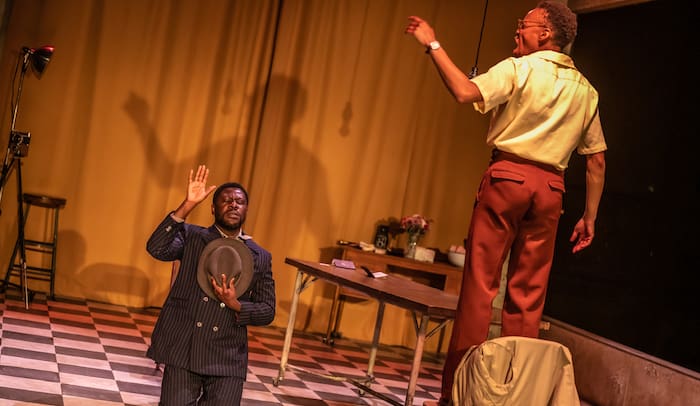Created in three weeks through collaborative improvisation, Athol Fugard, John Kani, & Winston Ntshona’s complex rumination on identity premiered in 1972 South Africa at incredible risk. The performers were jailed for their story of life under apartheid and the personal compromises forced upon Black and Coloured citizens in order to survive. It’s an honour to be able to attend a production with such an incredible legacy in 2023 Toronto and the strength of the production is a credit to Soulpepper’s evolution and the remarkable attention artistic director Weyni Mengesha pays to the full scope of potentially programmable art in the world and cast-able talent in the city (both performers are making their Soulpepper debuts).
The play’s originally improvised nature lends to some pacing issues, especially within a non-linear structure that facilitates a beautiful payoff but a meandering beginning. The play can mostly be divided into two parts despite being presented with no intermission, the shift clearly demarcated by Amaka Umeh changing characters from an energetic and charismatic photographer to a pragmatic and sarcastic problem solver. With Umeh’s characteristic physicality and boundless energy fully unleashed, act one takes the form of a 45 minute uninterrupted monologue that lets the inherent horrors of the setting simmer beneath wild jokes and elaborate roach-killing dance sequences. At times the wackiness grows tiresome as I longed for a little less space between heartrending stories about the importance of photographs and the lives of the people who pass through Styles’ Photographic Studio.
Though the stamina is impressive as an athletic feat, Umeh’s intensity works best for me when its balanced by either another actor or quieter moments. The second half of the play delivers just that as the story gets rolling, Umeh downshifts to a subtler character, and Tawiah M’Carthy enters the picture with a stirringly quiet performance. The joy of the first act is an important counterpoint to the sadness of the story as a whole and a beautiful subtextual nod to the resilience of the human spirit, it could just use a little tightening until its place in the overall narrative becomes clearer.

